|
Monday, July 19: D'Escousse - Robins The winds had dropped to light but would
become moderate later. On Tuesday, winds were expected to move into the
south and increase to force 4-5 by afternoon, with strong southeast winds
forecast for Wednesday. Rather than beat up Lennox Passage and try
to round Isle Madame counter-clockwise later in the week, it seemed better
to change plans and sail the other way. The coast exposed to the
open Atlantic should be free of swells after this period of northwesterlies.
Since most fog comes with southerly winds the coast should be clear till
late on Tuesday.
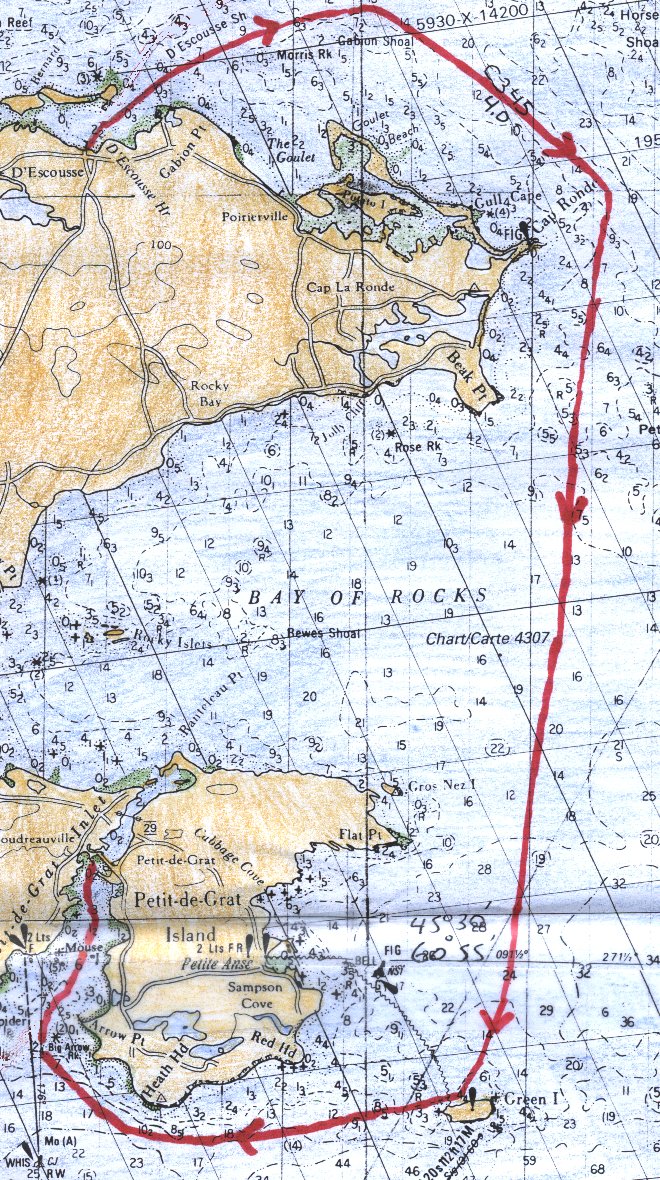 In the morning, Naomi coasted from the wharf at D'Escousse. The overcast sky was pierced with a few gaps through which sunbeams shone and reflected off the sea. Running before light northwest winds, I had an easy sail around Cap Ronde. Cap Ronde is a prominent headland attached to Isle Madame by a low spit. The light tower on the cliff will not last many more years as the soft cliff face rapidly erodes. Behind the cape, the coast was a mixture of pasture and forest with a few farms. |
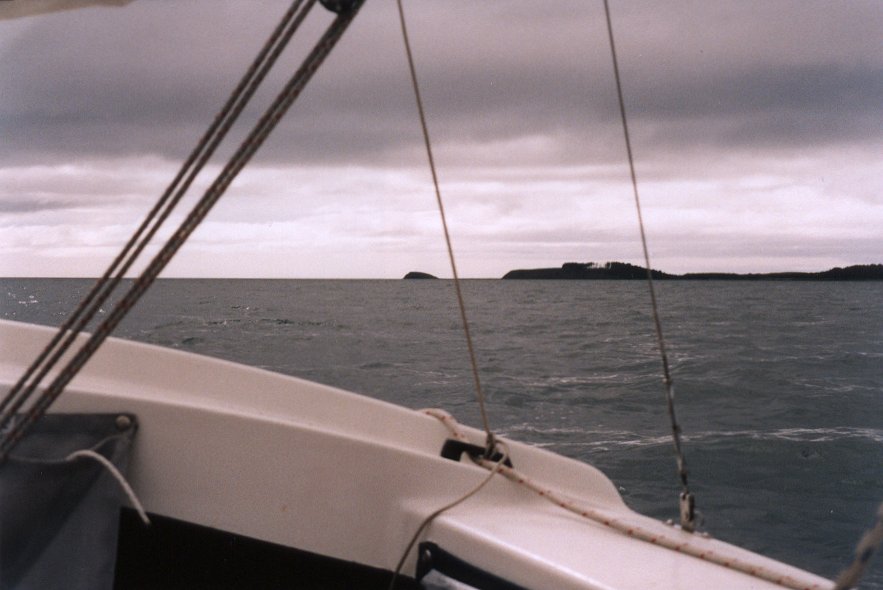 |
|
.. |
| After rounding Cap Ronde and Beak Point, I sailed across Bay of Rocks in the direction of Green Island. On the centre of this wind-swept island is a prominent lighthouse which is the eastern landmark for vessels entering the Strait of Canso. An alternative to sailing around the outer coast of Isle Madame would have been to go through the narrow passage separating Isle Madame from the island of Petit-de-Grat. There is a low bridge joining the islands that isn't an obstacle to a Wayfarer dinghy whose mast can be lowered easily. |
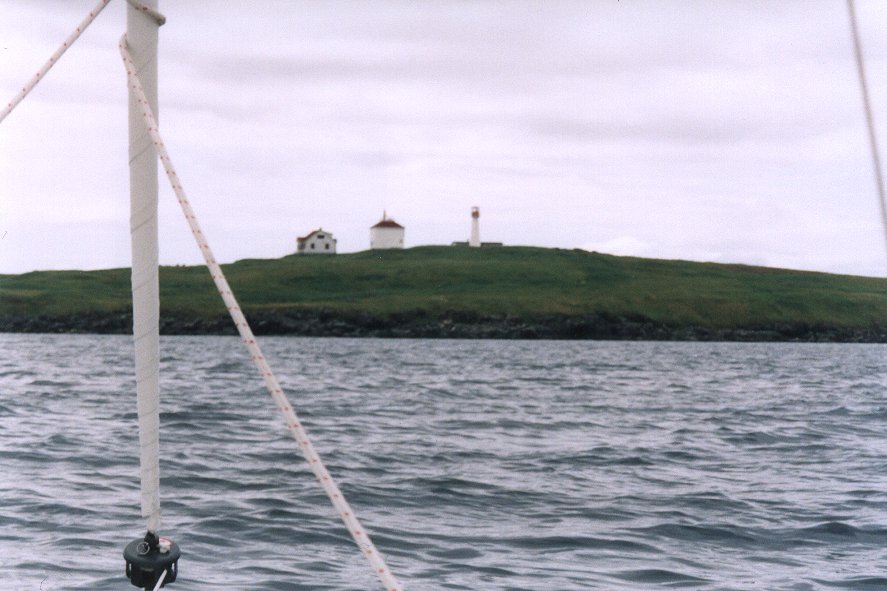 |
|
.. |
| Since the seas were low and winds light,
I considered going ashore on Green Island. After furling the jib
and dropping the main, I rowed up to a small inlet where a slipway once
existed. The light is now automated and the lighthouse keepers home
derelict. Helicopters service the lighthouse and the slipway has
been allowed to wash away. A low swell grinding on the rocks made
landing impossible.
Leaving Green Island and the quiet sailing of the morning I soon encountered different conditions. As I sailed towards Red Head the breezes were fickle and gusting about pointlessly. Once clear of Red Head the wind and sea were rough. Sailing into Chedabucto Bay was such a change. The wind was a fresh westerly of around 12 knots with stronger gusts. Waves were unnaturally steep-sided and frequently collapsed in spume. |
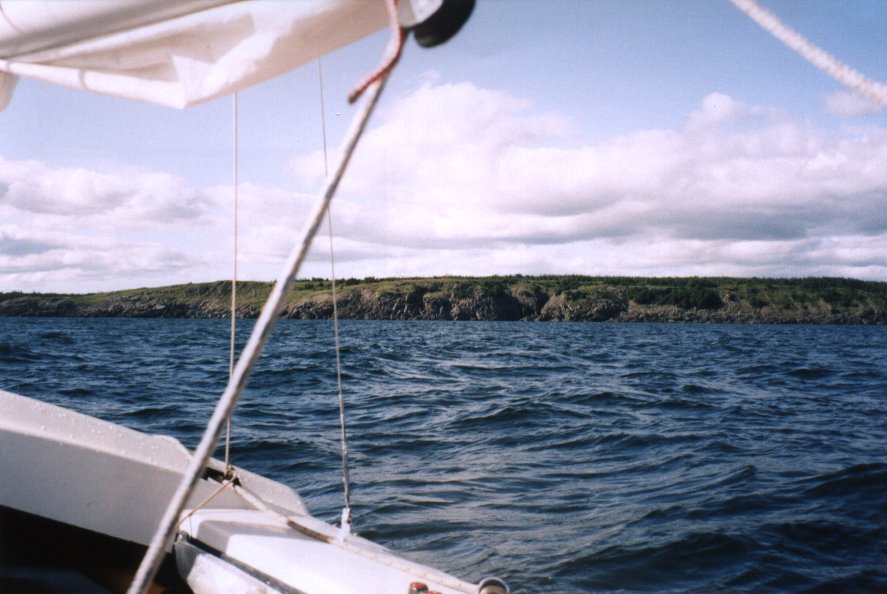 |
|
.. |
| Sailing now became worrisome.
I furled the jib and reefed the main. Naomi slogged slowly
to windward along the desolate coast. For a time, it appeared she
wasn't making headway at all. Green Island remained exactly the same
distance astern. With the seas so steep and breaking, I didn't have
the nerve to let Naomi lie ahull so I could put on foul weather
gear and a floater jacket. I shivered in the thin work clothes and
life vest I wore. Visions of what to do if Naomi capsized
occupied my mind. At this time, I considered that my wife's
hobby of gardening would be a pleasant alternative to dinghy sailing.
Gradually though, Naomi made headway along the coast. Features of the rugged cliffs slowly changed, and finally the roof-tops of buildings in Petit-de-Grat appeared. Spying a pair of fishing boats leaving harbour gave me some assurance if something went awry there was help available. Cape Hogan seemed a fair distance away, and rather than continue beating along the coast to Arichat, I changed course for Petit-de-Grat. Here I'd rest and warm up as I waited for the wind and sea to drop. I sailed Naomi right up to the government wharf near the bridge. At the wharf I tied Naomi at a berth marked "Patrol Vessel Only." The scorched side of the wharf indicated the fate of that vessel. Over the years, several fisheries patrol vessels have burnt or sunk at wharves in Nova Scotia. It must be a coincidence. Petit-de-Grat got its name from the early days of the fisheries. Fishermen left before dawn in their boats. When they returned in the evening, the fish were salted and prepared for drying. Sometimes they were fishing too far from their base to return and ready the fish in the same day. Secondary processing stations were built that could be dismantled and moved along the coast. The French called these stations "de'grats." The port is colourful and fishing still its main industry. Unfortunately the fishing industry is in such disarray. The largest fish plant was closed and looked so lifeless without the boats, birds, and smells always present. The co-op fish plant and smaller ones were still open though. |
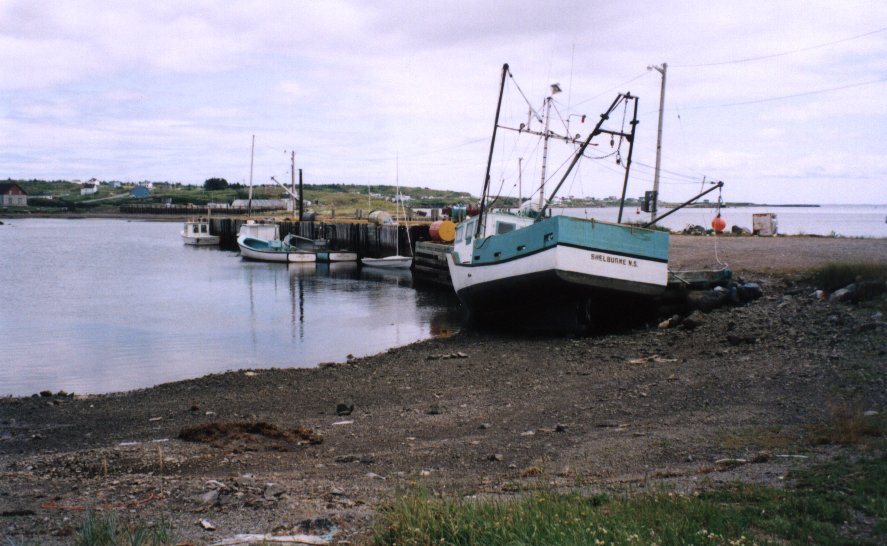 |
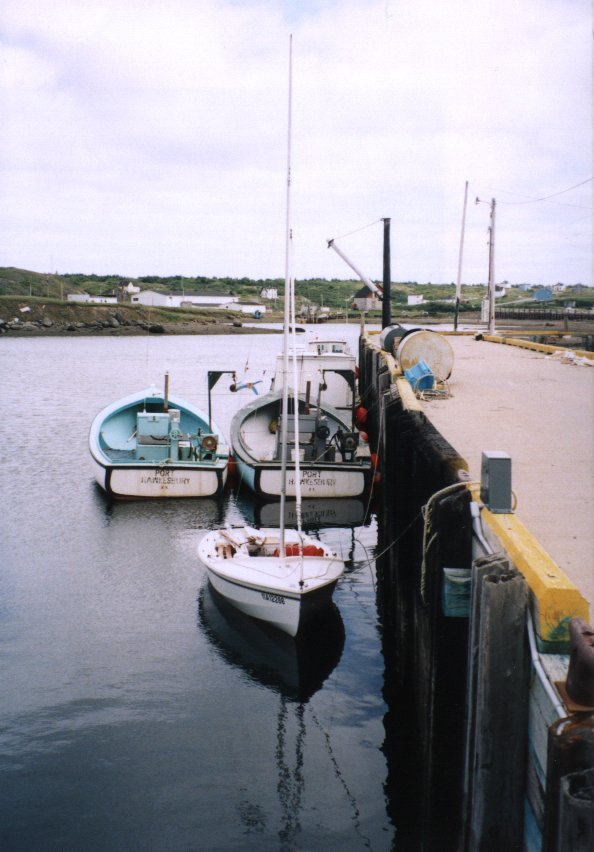 |
|
.. |
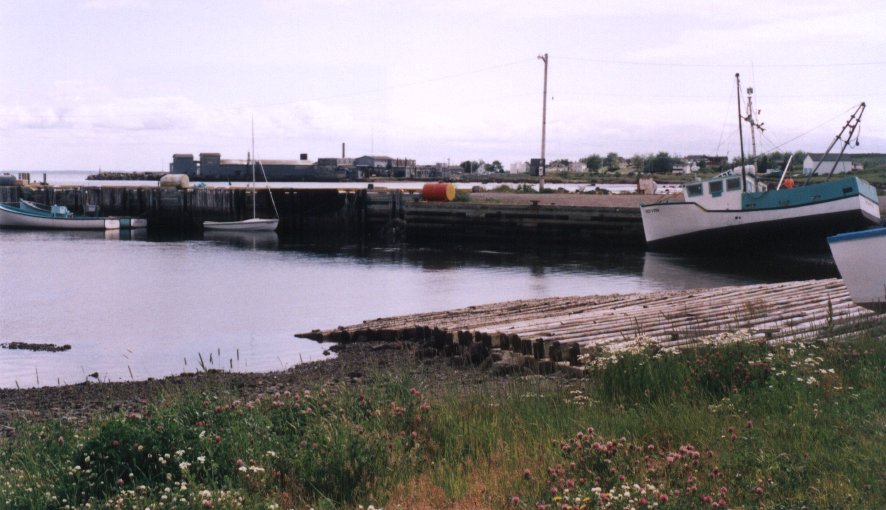 |
|
.. |
| A fisherman was repairing his vessel
by the wharf. I approached him to get his opinion on the weather.
He thought the wind was going down and it would be "right calm" by evening.
We sat on the wharf and chatted. He had just removed the cabin from
his fishing boat. Now he could sail her under the bridge at any tide
and tend his pots or fish on either side of the passage. He was re-mounting
the radar on the fore-deck as we talked. After 30 years on Great
Lake boats and 7 years deep-sea, he had returned home to Isle Madame.
Having seen my dinghy arrive, he pointed to a pair of open lobster skiffs
and suggested one of them would be a better boat if I intended cruising
here much. Fishing boats could be bought cheap with the problems
in the fishery.
After a walk around Petit-de-Grat and
lunch, I decided to continue on to Arichat. If the southerly winds
rose early on Tuesday it could be a miserable passage out of Petit-de-Grat
and around Cape Hogan. The fisherman offered to hand the lines from
the wharf cleats which were out of reach above my head. I thanked
him and idly did the last straightening away before sailing off the wharf.
Unexpectedly the lines came dropping into the boat and the breeze caught
the mainsail. Naomi's stern swung out, and she made an unplanned
departure after rubbing her nose along the sooty wharf side while tacking
instead of clearing the wharf and gybing as planned. As I sailed
from Petit-de-Grat, the two fishing boats were returning, each followed
by a host of noisy gulls. The fishermen must have been checking the
gill nets I saw strung off Green Island.
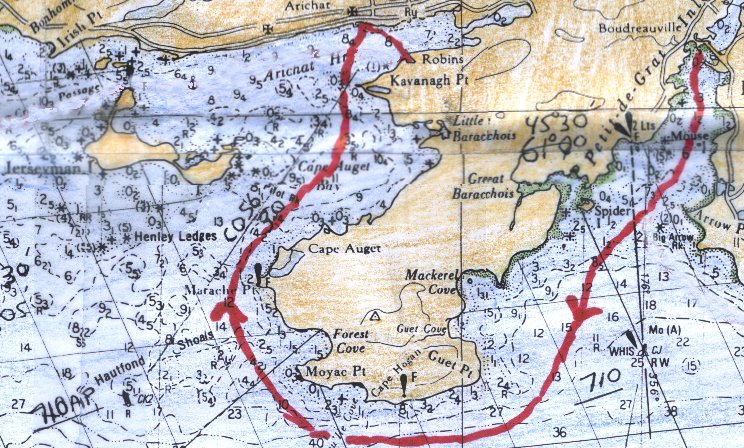 The winds were now about force 2-3 and the seas easy. There was little to break up the views of low cliffs, barren grassland, and short spruce trees along Cape Hogan. The only building was the large Clearwater plant at Presqu'Ile Cove. It once processed fish in addition to being a lobster pound. Now it is only a lobster pound into which the sea flows providing good living conditions for lobster which are shipped live to Europe and America. |
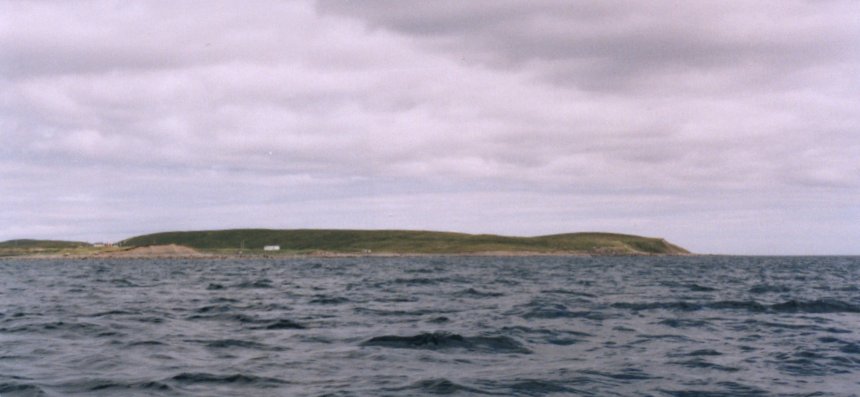 |
|
.. |
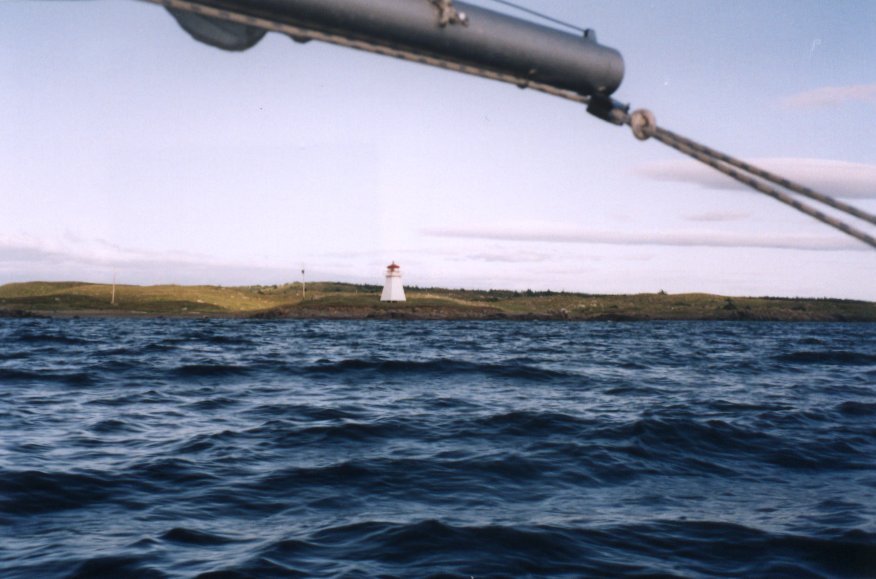 |
|
.. |
| Naomi finally rounded Marache Point and entered calm waters behind Jerseyman Island. This island was once the main base for the Robins family who were merchants from Jersey. In 1775 their warehouses and fish plant were burnt by the Yankee privateer, John Paul Jones. The Robins rebuilt their enterprise further up Arichat Harbour in a more secure cove. |
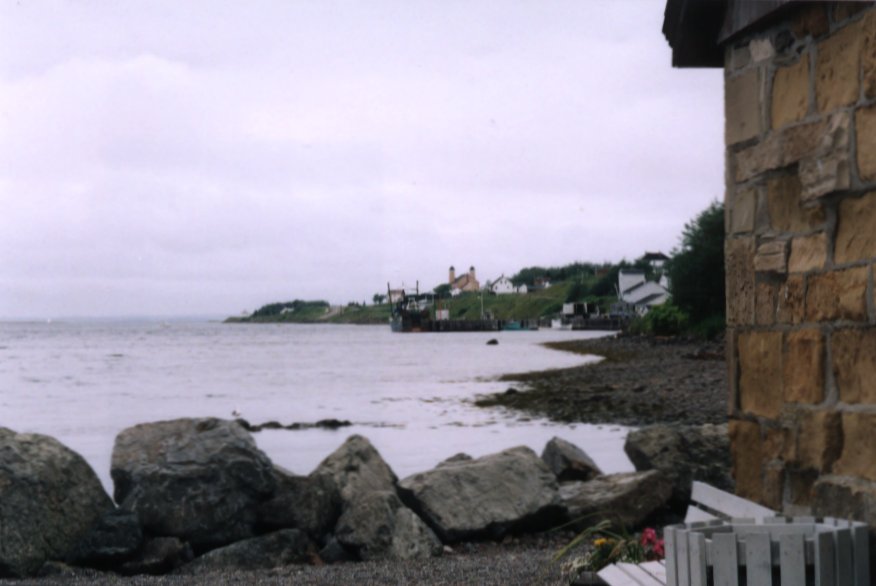 |
|
.. |
| I sailed across the harbour to Arichat
and called home from general store. When Gail learned I had been
sailing yesterday but on a schooner, she was quiet. I had actually
sailed my dinghy today to Arichat and really was on a cruise, I insisted.
In June, Kevin and I had taken his big home-built dory for a camping cruise
on the Bras d' Or Lakes. Following two nights camping on board his
dory, we contrived to find ourselves in Baddeck. The next two nights
we tarried at a rather expensive motel. We spent all our cash and
put a big dent in my charge card before leaving Baddeck.
On both days the weather had been fair, and it was only after we left Baddeck the weather worsened. Our wives look at us with suspicion when the subject of solitary cruises in small boats arises. One thing Kevin and I learned from the experience was to carry more cash next time. A charge card leaves an embarrassing paper trail of the costs and locations of the motels, liqueur stores and restaurants visited during our wilderness adventures. After rowing back across the harbour, I tied Naomi alongside the wharf at the Isle Madame Yacht Club in Robins Cove. The wharf is in good shape and there are several mooring buoys nearby. The club consists of two old fish shacks for storage on a sand spit. A clubhouse is planned for construction soon. I rigged the boom tent and cooked supper by the wharf. A man drove onto the wharf and welcomed me to the club. He then offered to drive me into Arichat if I needed supplies. Finally he suggested if the wharf lights bothered me during the night to pull the plug on them. Where I tied Naomi, I believed there was ample depth so she wouldn't dry out at low tide. During the night I awoke to find Naomi listing considerably away from the wharf side. I shifted myself into a more comfortable position and tried to go back to sleep thinking she must have grounded anyway and since the bottom was mud it didn't matter. Then the truth came, and I knew quite well what was happening. Hesitantly, I reached for the stern line - it was taut. I had not left enough line for the spring tides. Naomi, with camping gear and myself, was gradually being supported by the mooring lines only to the wharf while the tide still ebbed. Quickly I climbed onto the wharf and slacked off the lines. Dense! |